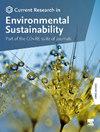印度西海岸椰子种植系统的经济、能源预算和环境影响评估
IF 3.8
Q2 ENVIRONMENTAL SCIENCES
Current Research in Environmental Sustainability
Pub Date : 2025-01-01
DOI:10.1016/j.crsust.2025.100289
引用次数: 0
摘要
一个可持续的农业生产系统应该是经济上可行的、节能的和生态友好的。本研究旨在评估印度果阿七种不同椰子种植系统的经济可行性、能源效率和环境影响。该系统包括椰子(Cocos nucifera L)单一作物和各种间作组合,如鸡腿(Moringa oleifera)和木瓜(Carica papaya),向日葵(heliconia psittacorum)或香蕉(Musa sp.,)和柠檬(Citrus limon),菠萝(Ananas comosus)和西番莲(Passiflora edulis),以及十字花科(crossandra infundibuliformis)。结果表明,椰子+菠萝+百香果体系和椰子+海葵体系在经济效益和能量输出方面都有较好的发展前景。然而,椰子+木瓜+鸡腿系统显示出最高的全球变暖潜能值(GWP),因为在作物周期中需要大量的投入。椰子+菠萝+百香果体系的经济效益最高,平均每公顷可增加8605个椰子当量产量,效益成本比高达1.99,平均净收益为1558.5美元/公顷。根据输入和输出的计算能量值对系统之间的能源效率进行比较,椰子+向日葵系统的效率最高,为45.3。使用ReCiPe 2016 (H) Midpoint方法计算生命周期清单,由于投入消耗较低,椰子单一作物系统的GWP最低。椰子+山楂和椰子+刺果复合农林业组合的GWP值与椰子单作相差不大,但投入需要量高于椰子单作。农场排放对全球变暖潜值的贡献显著,从椰子+凤仙花的73%到椰子+凤仙花的40%不等。氮肥和燃料密集型耕作作业被确定为所有耕作系统中能源消耗和全球升温潜能值较高的主要贡献者。总之,椰子+番荔枝系统已被证明具有最佳的生产力、利润、节能和环保。此外,该系统还提供了纳入胡椒和菠萝等各种间作的机会,以改善印度西海岸地区的多种生态系统服务。研究结果强调,选择低投入、适应遮荫的作物可以优化资源利用、减少排放并增强可持续性。本文章由计算机程序翻译,如有差异,请以英文原文为准。
Economics, energy budgeting and environmental impact assessment of coconut-based cropping system in the west coast of India
A sustainable agricultural production system should be economically viable, energy-efficient, and eco-friendly. This study aimed to assess the economic viability, energy efficiency, and environmental impact of seven different coconut-based cropping systems in Goa, India. The systems included coconut (Cocos nucifera L) monocrop and various intercropping combinations such as drumstick (Moringa oleifera) and papaya (Carica papaya), heliconia (Heliconia psittacorum) or banana (Musa sp.,) and lemon (Citrus limon), pineapple (Ananas comosus) and passion fruit (Passiflora edulis), and crossandra (Crossandra infundibuliformis). Results indicated that the coconut + pineapple + passion fruit system and coconut + heliconia system showed promising in terms of both economic returns and energy output. The coconut + papaya + drumstick system, however, showed the highest global warming potential (GWP) due to considerable input requirements during the crop cycle. The coconut + pineapple + passion fruit system exhibited the highest economic returns with an average additional coconut equivalent yield of 8605 nuts per hectare, a high benefit-to-cost ratio of 1.99, with an average net return of USD 1558.5 per hectare. Energy efficiency among the systems was compared based on computed energy values for inputs and outputs, highest efficiency at 45.3 was recorded in the coconut + heliconia system. Using the ReCiPe 2016 (H) Midpoint method, life cycle inventories were calculated, and the coconut monocrop system showed the lowest GWP due to its lower input consumption. The agroforestry combinations of coconut + crossandra and coconut + soursop showed nearly equivalent GWP as that of coconut monocrop despite their higher input requirement over coconut monocrop. On-farm emissions were found to contribute significantly to the GWP, ranging from 73 % in coconut + crossandra to 40 % in coconut + heliconia. Nitrogenous fertilizers and fuel-intensive tillage operations were identified as major contributors to both higher energy consumption and GWP in all the cropping systems. In conclusion, the coconut+soursop system has proven to be optimally productive, profitable, energy-efficient, and eco-friendly. In addition, this system offers the opportunity to incorporate various intercrops such as pepper and pineapple, to improve multiple ecosystem services in the West Coast region of India. The findings emphasize that selecting low-input, shade-adapted crops can optimize resource use, reduce emissions, and enhance sustainability.
求助全文
通过发布文献求助,成功后即可免费获取论文全文。
去求助
来源期刊

Current Research in Environmental Sustainability
Environmental Science-General Environmental Science
CiteScore
7.50
自引率
9.10%
发文量
76
审稿时长
95 days
 求助内容:
求助内容: 应助结果提醒方式:
应助结果提醒方式:


